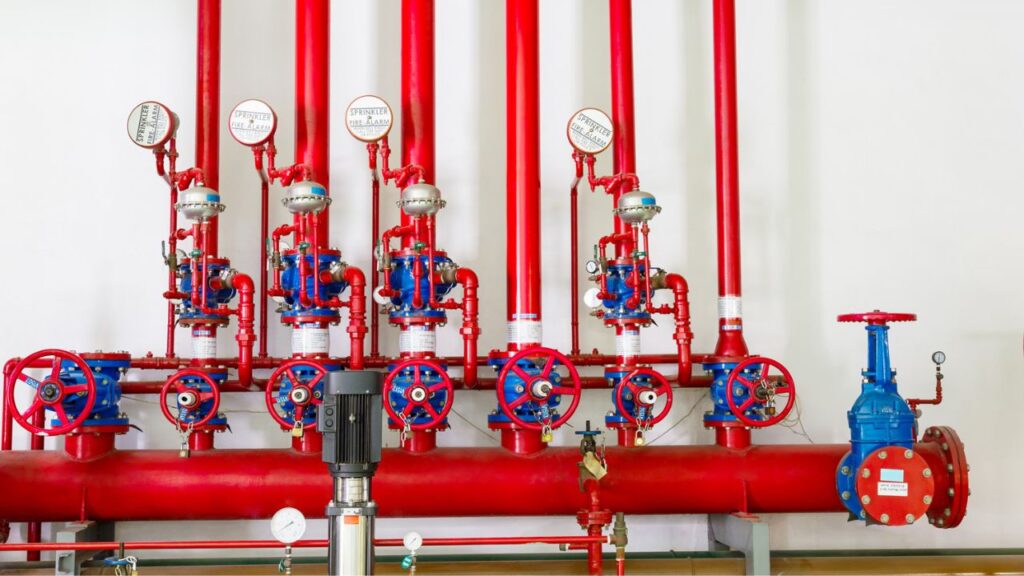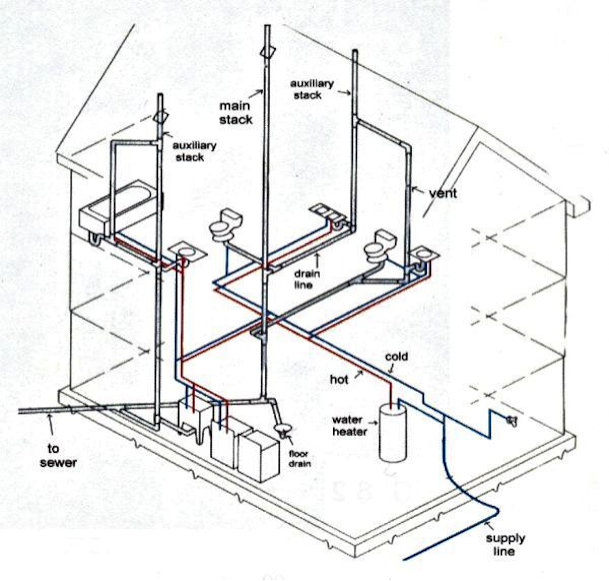What The Design of Your Home's Plumbing System Matters
What The Design of Your Home's Plumbing System Matters
Blog Article
Just how do you actually feel about Plumbing Installation 101: All You Need to Know?

Comprehending how your home's plumbing system works is crucial for every home owner. From providing tidy water for drinking, food preparation, and bathing to securely removing wastewater, a well-kept pipes system is important for your family members's health and comfort. In this detailed guide, we'll explore the elaborate network that composes your home's plumbing and offer pointers on maintenance, upgrades, and dealing with usual concerns.
Introduction
Your home's pipes system is greater than simply a network of pipes; it's a complicated system that guarantees you have accessibility to tidy water and effective wastewater removal. Understanding its elements and exactly how they work together can assist you avoid expensive repair work and make sure every little thing runs efficiently.
Basic Components of a Plumbing System
Pipes and Tubing
At the heart of your plumbing system are the pipelines and tubing that bring water throughout your home. These can be constructed from different products such as copper, PVC, or PEX, each with its benefits in regards to longevity and cost-effectiveness.
Components: Sinks, Toilets, Showers, and so on.
Components like sinks, bathrooms, showers, and tubs are where water is made use of in your house. Comprehending exactly how these fixtures connect to the plumbing system assists in diagnosing problems and intending upgrades.
Shutoffs and Shut-off Points
Valves regulate the circulation of water in your pipes system. Shut-off shutoffs are essential during emergencies or when you need to make repairs, permitting you to separate parts of the system without interfering with water circulation to the entire residence.
Supply Of Water System
Main Water Line
The major water line links your home to the community water supply or an exclusive well. It's where water enters your home and is dispersed to various fixtures.
Water Meter and Stress Regulatory Authority
The water meter steps your water use, while a pressure regulatory authority makes sure that water streams at a safe stress throughout your home's plumbing system, preventing damages to pipes and components.
Cold Water vs. Warm water Lines
Recognizing the distinction in between cold water lines, which supply water straight from the primary, and hot water lines, which lug heated water from the hot water heater, assists in troubleshooting and planning for upgrades.
Drain System
Drain Water Lines and Traps
Drain pipes lug wastewater away from sinks, showers, and commodes to the sewer or sewage-disposal tank. Traps protect against drain gases from entering your home and also catch debris that can trigger clogs.
Air flow Pipes
Air flow pipes allow air right into the drain system, stopping suction that might slow water drainage and trigger traps to vacant. Appropriate ventilation is crucial for preserving the integrity of your pipes system.
Significance of Proper Water Drainage
Guaranteeing correct drain prevents backups and water damages. On a regular basis cleaning up drains pipes and preserving catches can avoid pricey repair work and expand the life of your plumbing system.
Water Heating System
Kinds Of Water Heaters
Hot water heater can be tankless or traditional tank-style. Tankless heating units warmth water on demand, while containers save heated water for prompt use.
Updating Your Plumbing System
Factors for Updating
Updating to water-efficient fixtures or changing old pipes can enhance water quality, minimize water costs, and enhance the worth of your home.
Modern Plumbing Technologies and Their Advantages
Check out modern technologies like smart leakage detectors, water-saving commodes, and energy-efficient water heaters that can conserve cash and reduce environmental impact.
Expense Considerations and ROI
Compute the upfront prices versus long-term cost savings when taking into consideration plumbing upgrades. Several upgrades spend for themselves through lowered utility expenses and fewer repair services.
Just How Water Heaters Attach to the Plumbing System
Recognizing exactly how hot water heater connect to both the cold water supply and warm water distribution lines assists in diagnosing problems like not enough warm water or leaks.
Upkeep Tips for Water Heaters
Routinely purging your water heater to eliminate sediment, examining the temperature level settings, and checking for leaks can prolong its life-span and improve power performance.
Common Pipes Concerns
Leakages and Their Causes
Leaks can take place due to aging pipelines, loose fittings, or high water stress. Addressing leaks quickly protects against water damage and mold development.
Obstructions and Blockages
Blockages in drains pipes and toilets are often triggered by purging non-flushable items or an accumulation of oil and hair. Making use of drain screens and bearing in mind what drops your drains pipes can prevent blockages.
Indications of Pipes Issues to Look For
Low water pressure, slow drains pipes, foul odors, or abnormally high water costs are indicators of potential plumbing troubles that need to be resolved without delay.
Pipes Upkeep Tips
Normal Assessments and Checks
Arrange annual plumbing evaluations to capture problems early. Search for signs of leaks, deterioration, or mineral build-up in taps and showerheads.
Do It Yourself Maintenance Tasks
Easy tasks like cleansing tap aerators, looking for bathroom leaks using dye tablets, or protecting subjected pipelines in cool environments can protect against significant plumbing problems.
When to Call an Expert Plumbing
Know when a plumbing issue requires professional knowledge. Attempting intricate fixings without correct expertise can cause even more damage and greater fixing prices.
Tips for Minimizing Water Usage
Basic routines like repairing leaks promptly, taking much shorter showers, and running complete tons of laundry and dishes can conserve water and reduced your energy expenses.
Eco-Friendly Plumbing Options
Think about sustainable pipes products like bamboo for floor covering, which is durable and eco-friendly, or recycled glass for counter tops.
Emergency situation Readiness
Steps to Take During a Pipes Emergency situation
Know where your shut-off valves are located and just how to shut off the supply of water in case of a ruptured pipe or major leakage.
Value of Having Emergency Calls Helpful
Keep get in touch with details for regional plumbing technicians or emergency services conveniently offered for quick response during a pipes dilemma.
Environmental Influence and Conservation
Water-Saving Fixtures and Home Appliances
Installing low-flow taps, showerheads, and bathrooms can significantly lower water usage without giving up efficiency.
DIY Emergency Situation Fixes (When Appropriate).
Momentary fixes like making use of duct tape to spot a leaking pipeline or putting a pail under a leaking faucet can reduce damages until a specialist plumber shows up.
Verdict.
Comprehending the makeup of your home's plumbing system encourages you to preserve it properly, conserving time and money on repair services. By following routine upkeep routines and remaining educated about contemporary plumbing innovations, you can guarantee your pipes system operates successfully for years to find.
HOW YOUR PLUMBING SYSTEM WORKS
Which Pipes Do What?
Blue lines = fresh water supply entering the building Red lines = hot water supply entering the building Grey lines = pipes carrying waste away from the building and venting pipes carrying gases away from the building (through the roof) YOUR MAIN PLUMBING SYSTEMS
There are two main plumbing systems that support your home s basic plumbing needs one that brings clean water into your home, and one that sends dirty water away from your home. Connected to the toilet, bath, shower, and other faucets in your home, these two systems keep your water flowing in the right directions.
ACCESSING FRESH WATER
Fresh and clean water is brought into your home through the main water supply line . Filtered through one pipe, this water is pressured to flow into the various fixtures in your home at any given time.
This water can be sourced from a well located on your property, a pond or river (mostly cottages), or, as in most cases, from the city s municipal water treatment centre. However, it is important to note that water that is untreated, such as the water siphoned from ponds or rivers, may not be safe to drink. Personal water supplies always need to be treated for hardness and contaminants before consumed.
MUNICIPAL WATER SUPPLIES
Improve taste and odour Remove sediment Eliminate hardness Reduce chlorine COLD WATER SUPPLY VS. HOT WATER SUPPLY
Cold water flows into your home or building through the service line, which then distributes hot or cold water to your fixtures. This line is most commonly run through a central column that runs floor to floor. Hot water runs in short and straight pipes as the longer the pipeline, the more heat that will be lost in the transfer. Having shorter pipes also allows residents to access hot water more quickly.
WASTE WATER SYSTEM
Your wastewater system is divided into two parts pipes that send wastewater away from your home and venting pipes that send sewer gas away from your home. Sewage water travels through pipes that flush the water and waste towards local sewers that are operated and managed by your city or town. Most sewer systems rely on gravity to move the wastewater to where it needs to go.
The further away from your toilet or sink, the larger wastewater pipes become. This allows for waste to be disposed of from various parts of your home or business at once without pipe blockages. The angle and flow of these pipes are also essential for keeping your waste pipes clear of build up.
https://harrisplumbing.ca/how-your-home-plumbing-system-works/

We were shown that write-up on from a pal on a different blog. Liked our write-up? Please quickly share it. Help someone else locate it. We value your readership.
Get A Free Quote Report this page